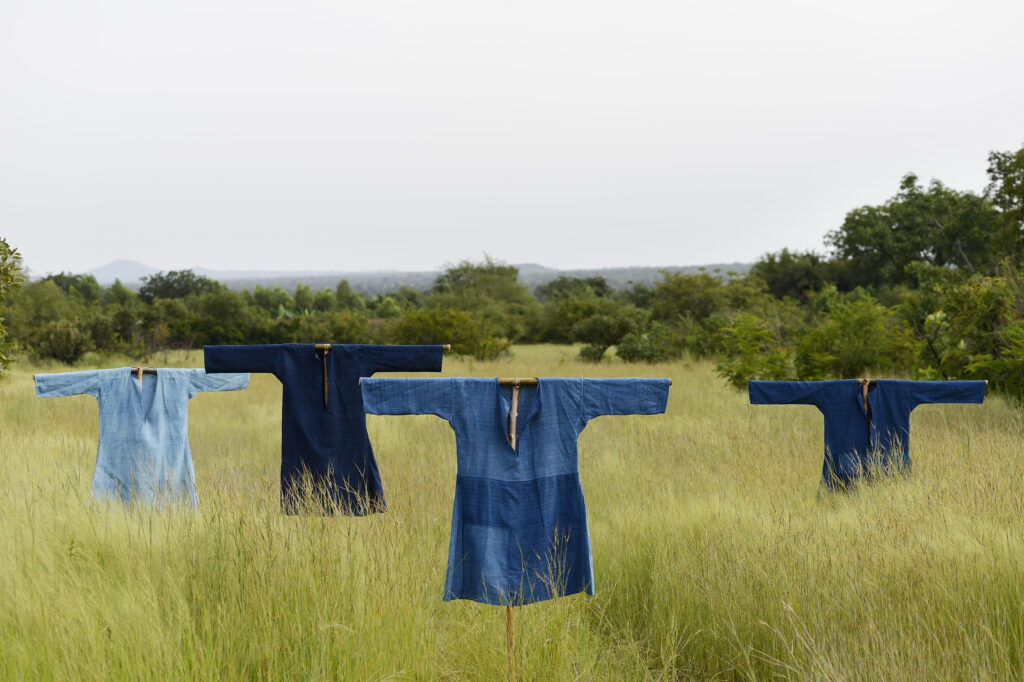
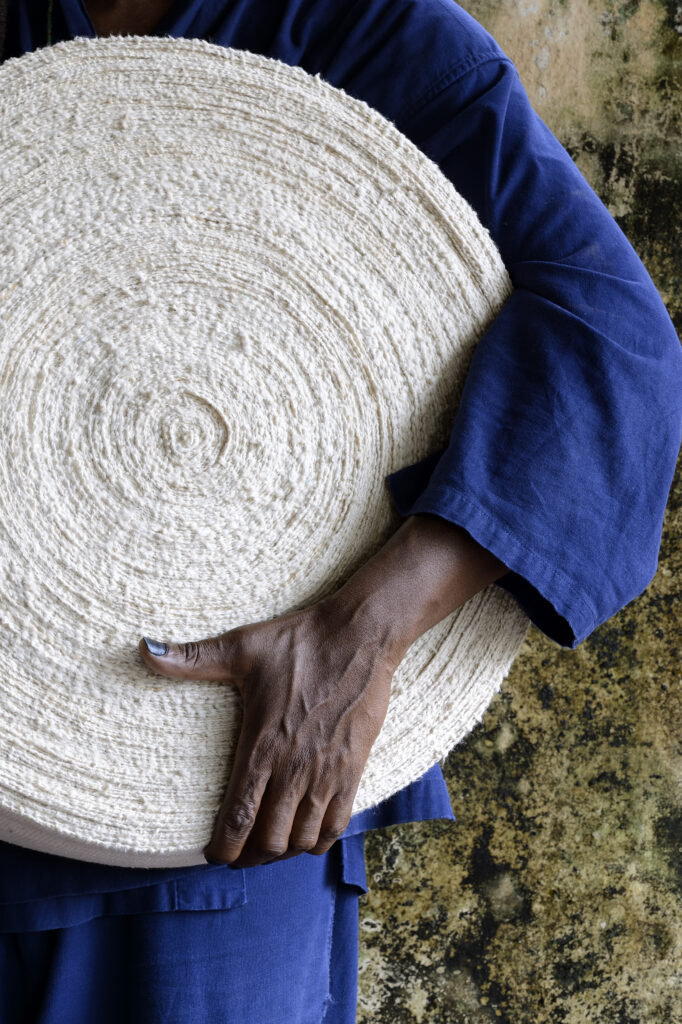
I think of myself more as a farmer and a nurturer than as a dyer, because long before the blue colours ever appear, I must grow the primary material and transform it.
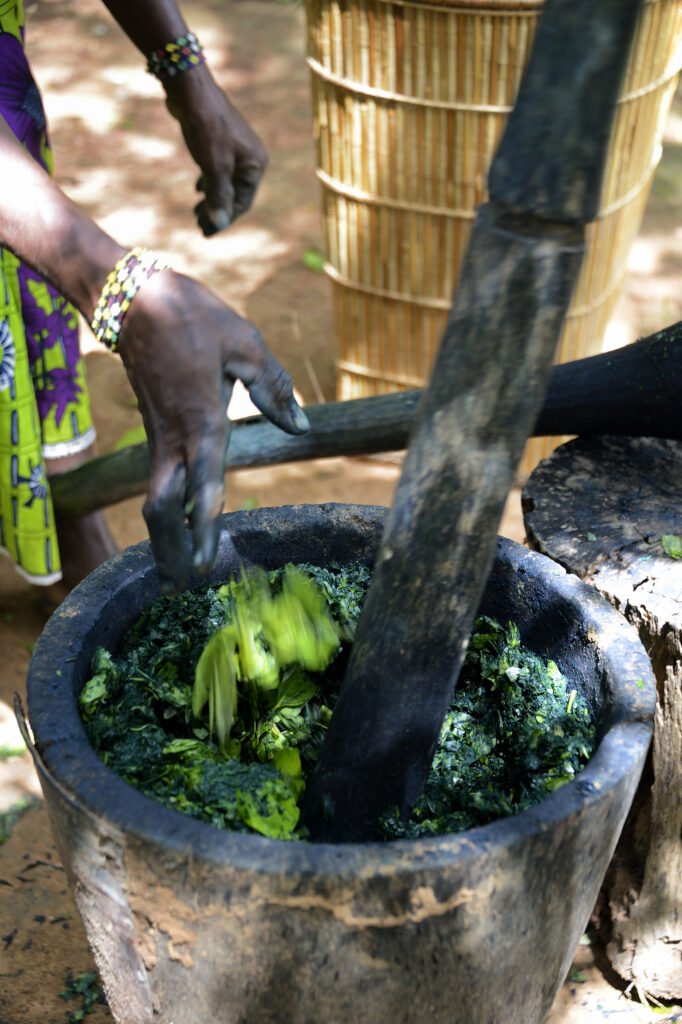
I’m often asked about how I see blue as a colour and what it means to me.
Frequently, the people who ask those questions are asking about a perception of colour, or a physical idea of the colour blue. But for me, the colour of much of my work can never be separated from the materials, the spirituality, or the history of the indigo plant for the people indigenous to the areas where it comes from.
The short answer to the question ‘how do you perceive the colour blue?’ is that I think more about a range of blues than I do about a single notion of blue. In classical Malian culture, an accomplished indigo dyer was able to create a minimum of twelve shades of blue. In my journey with indigo, I have given a huge amount of work to learning about these twelve shades. During his lifetime, my spiritual father, Youssouf Tata Cissé, spent much time talking to me about the names of these twelve shades and what they mean. Everything in our culture once had a name that was both its use-name and also a link to something larger – an idea, a spiritual notion, a social practice, a parable. So you can speak of the object as in everyday speech, but you can also use its name to invoke these other ideas. In Malian spiritual practice, which long predates the arrival of Islam in Africa, we say that the name came before the object it represents – that an idea is at least as important as an outcome. An idea exists before and it exists afterwards. Even if there is no one to speak it, it exists. For the shades of indigo it is no different, although for many decades, many of these names were lost or only known to very few people.
In my work, the first shade I can create is not my creation at all. It is the raw fibre before it is dyed. All of the shades that I create can only be gradated by reference to the undyed cloth. Our perception of all colours is altered by the colours around them, even when they are essentially shades of the same colour. The medium-dark shades I can create may look dark on their own until they are compared to the darkest shade of all, lomassa dunné.
But the truth of my work is that, although I am looking at the colours I create as I work, judging the shade and beauty of the blues, I am far more looking at these colours as a reflection of the health of my vats. I think of myself more as a farmer and a nurturer than as a dyer, because long before the blue colours ever appear, I must grow the primary material and transform it. I must set the vats using many kilos of dried leaves, and tend those vats until the bacteria in them grow numerous enough that they draw the pigment out of the leaf mass, and the oxygen out of the vat, forcing the reduction which allows dyeing to take place. All of these steps take many months, and caring for the bacteria in my vats is a daily practice. I cannot dye enormous amounts of fibre in my vats in any set amount of time: the vats must rest after a couple of hours of use, otherwise I will exhaust the bacteria and they will die, and the vat will fail and I will need to tip it onto my gardens. The collaboration between the bacteria and myself is not immediately apparent in the end product of my textile pieces. When the cloth is taken from the vat, and is finished and dried, and shown to someone who is not an indigo dyer who uses bacterial vats, what they see is blue.
I feel that the way that indigo dyeing is widely practiced now mislays connection to the original source material. The availability of powdered indigo pigment as a commercial product reduces contact with the plant source of the colour. For me, and for all Indigenous indigo dyers throughout the world, the creation of the colour starts in the soil and moves up to open to the sun, through the roots and leaves of the indigo plants. Even before that, it starts with my ancestors, the people who came before me and inhabited the spaces I now inhabit. These people are around me all the time. For us in Mali, as an animistic culture, all time is now, and everything that was once present is still present. I cannot move through my world and my work without being conscious of what came before me because all that came before is here with me, always. My grandmother, who was a healer, considered that the plants she used in her work were giving their souls, not just their physical properties. It is the same with my indigo vats and their outcomes of blue cloth. The souls of the indigo plants are present in the cloth.
We have many different species of indigo-bearing plants throughout Africa. Two of them, especially rich in pigment, are native to the regions of Mali and Guinea, where the practice of dyeing that I have inherited originated. It is beyond belief to think that the original human inhabitants never noticed these plants, and never used them for dyeing. I think of the dye practices of West Africa as extremely old – Western notions always demand an exact time. I can with confidence say they are very much older than Japanese traditions, which were passed to Japan from the ancient practices of China and Korea within the last thousand years. To me, logically, indigo dyeing in West Africa has existed as long as humans have existed there, which is a very long time indeed.
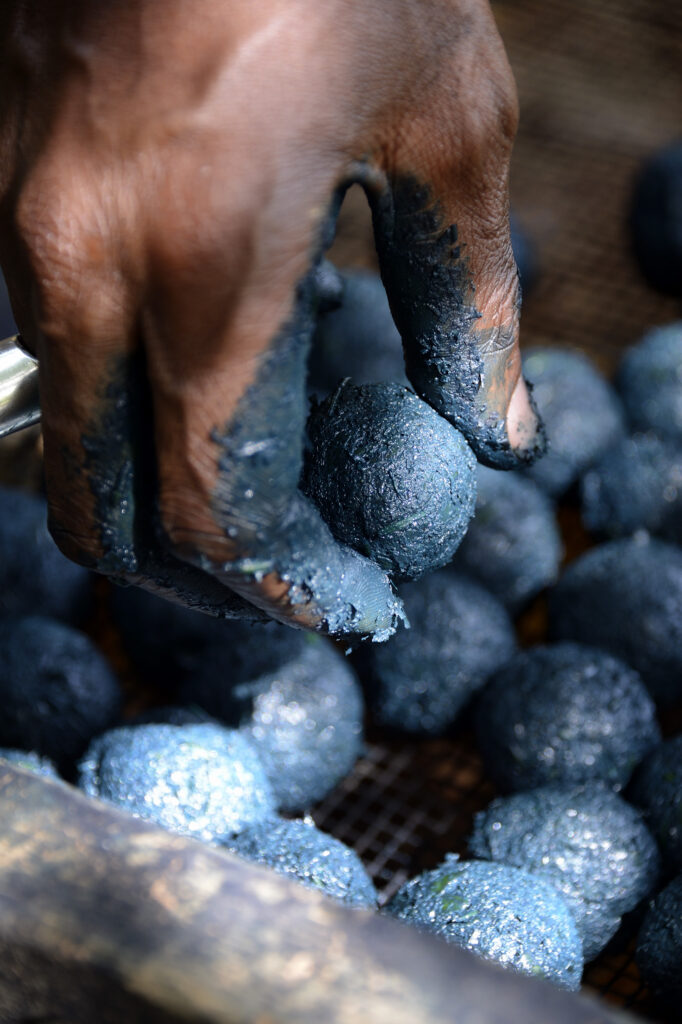
Photo by François Goudier 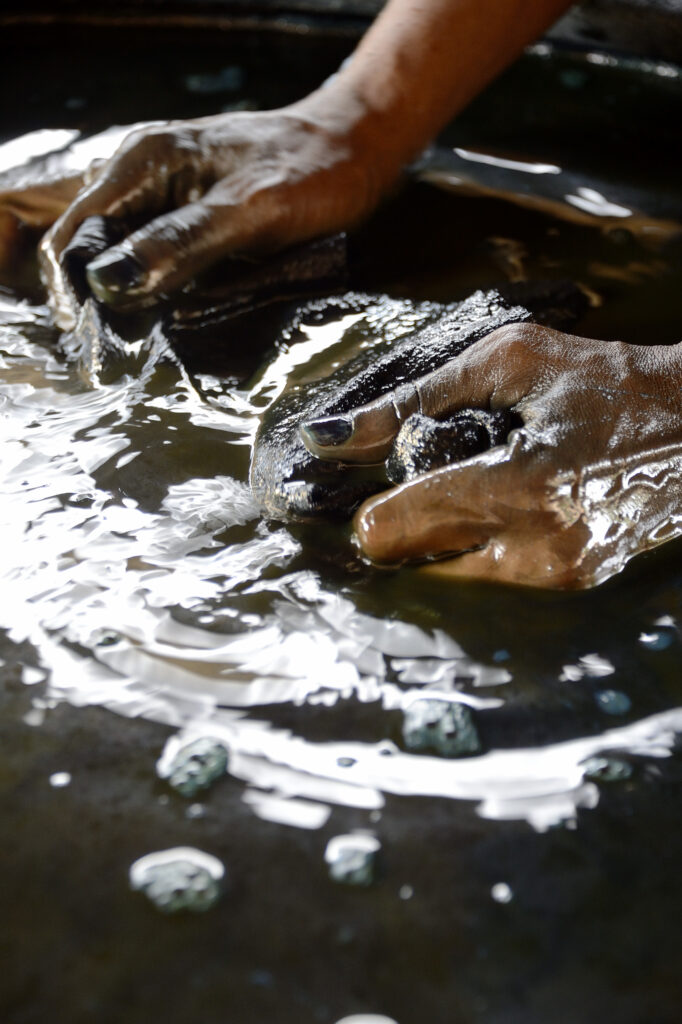
Photo by François Goudier 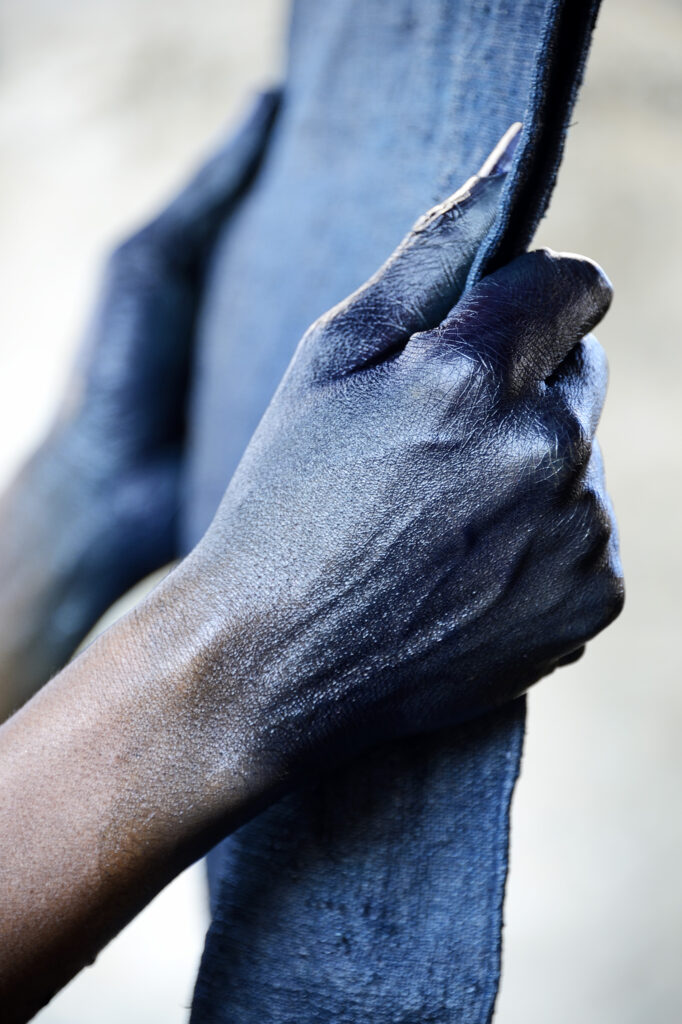
Photo by François Goudier
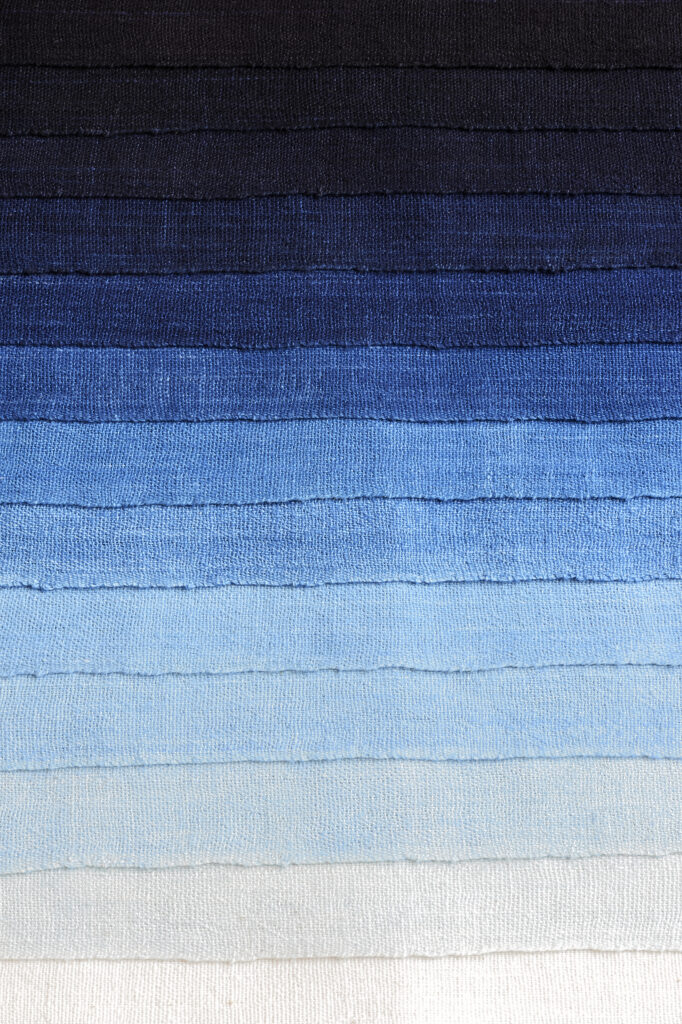
My grandmother, who was a healer, considered that the plants she used in her work were giving their souls, not just their physical properties. It is the same with my indigo vats and their outcomes of blue cloth. The souls of the indigo plants are present in the cloth.
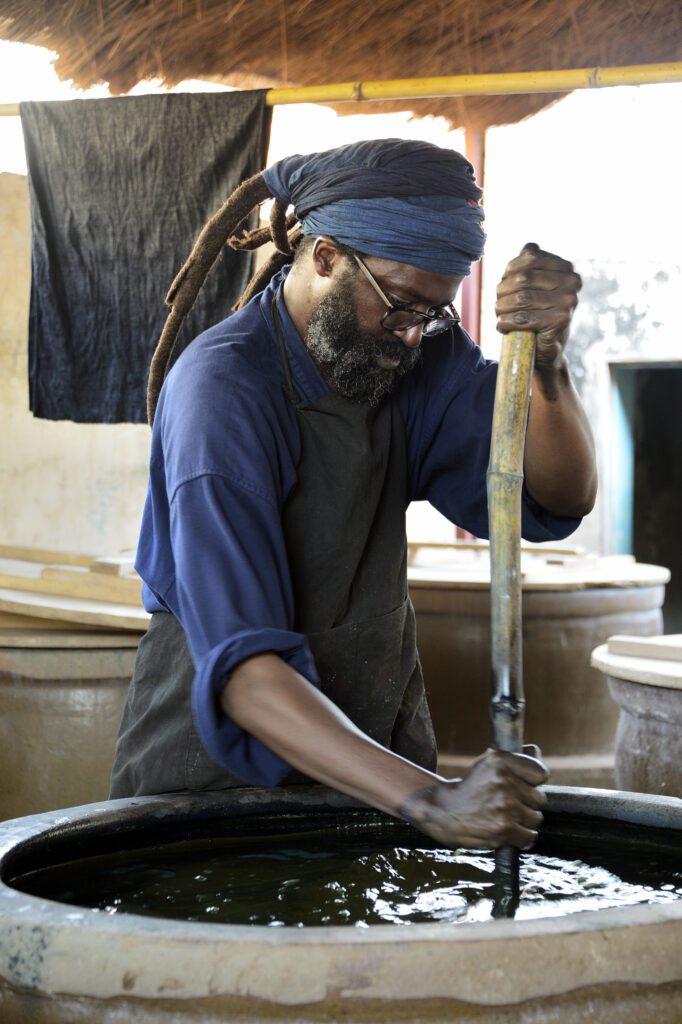
The length of time this dyeing practice has existed can be seen in its complexity. My vats use whole leaves, lye (ash-water), a fermenting agent (like tamarind pulp, crushed date powder, or honey), cereal bran, and nothing else. Yet it took me over a decade to master the process of building a vat to the point it can be used and maintaining that vat so that the bacteria in it live for many months. Learning how to raise those bacteria and keep them healthy is a work which has consumed me, obsessed me, every day for almost my entire life. It is a work which involves all of my senses as well as all of my spirit, and it is a work which has built my life and my spiritual beliefs.
There are as many techniques of indigo dyeing as there are regions of the world where indigo grows indigenously, but the mastery of the fermented whole-leaf vat is amongst the most difficult of these techniques. I am one of a long line of indigo dyers, and my understanding of the work involves a knowledge of their work. I can say with utmost certainty that the complexity of this knowledge could never have evolved over the lifetime of one human, or even the successive lifetimes of many humans. I could not have come to my practice if it had never existed before I did. But it did exist, for many thousands if not hundreds of thousands of years.
In Bamanankan, the name mà ngálábá yírí translates as ‘the Creator’. The same word holds the root of the name for indigo-dyed cloth and for indigo pigment – gálá. Indigo plants are known as gálá yírí, which translates as ‘Divine Tree’. Indigo dyeing as practiced in West Africa was always deeply spiritual, and our language shows our link to indigo as divine, as deep and as old as our link to our own humanity. Still, regularly, in books I see no mention – or only a passing mention – of African indigo. Often it is called ‘Yoruba Indigo’, which deftly attributes indigo to a single cultural group inside a single country rather than associating it with hundreds of cultural groups across many countries – a reduction as colonial as the word indigo itself.
So much of the focus on indigo in the West nominates it as a dyestuff that seems to come primarily from two regions of the world, India and Japan. Even the name given to the dyestuff – ‘indigo’ in the West – reflects this belief. I rarely see the two species of indigenous African plants that I use recorded correctly in print with their Latin names – Philenoptera cyanescens and Indigofera arrecta. Almost always, one is left out, and the other is incorrectly named ‘Indigofera tinctoria‘ – Indian indigo. This reflects a common idea that indigo dyeing was brought to Africa from outside, from India. This deeply colonial idea is both damaging and widespread, and it is an impossibility, given our origins and our environment. It reflects the conception that something only exists where Westerners have been able to discover, exploit, quantify, and report on it.
The uses of indigo in India, Bangladesh and Pakistan are exceptionally ancient; the ancestors are everywhere. These practices are well-documented in the West because it was this region that was first pillaged by Western colonisation for this dyestuff. It was a Western adaptation of an Indian method of dyeing, using pre-extracted pigment, that was easily transportable and could be used in inert, measurable vats which was the most easily exploitable for Western commerce. West African methods – which used whole leaves in huge quantities, and which relied on exact conditions and constant attention for the bacteria to thrive – were never exploitable. So they were cast aside.
In India, from my experience, much of the indigo powder used within the region and exported for overseas sale isn’t even of plant origin; it is petrochemical. The real cost of a kilo of indigo powder should be enormous, and the real skill of Indian textile artisans should be valued likewise, for they also are heirs to incredibly rich, ancient and exacting traditions. But generations of Western intervention have seen everything cheapened. Very few people now have the skill to know the difference, either in the dyestuff or in the blue-dyed cloth. The end result of colonialism is always a cheap, violent, banality masquerading as history, beauty, and skill. The colours may be superficially the same, but the practice and the impact can never be.
Indigo came to the New World because of colonisation, of India and of Africa. In my mind, I cannot ever separate the injustices done to the people of the Indian subcontinent from those done to my own. The scalable, measurable techniques of Indian indigo pigment dyeing were exported to the New World, but it was African knowledge of how to grow and transform indigo that allowed it to flourish, in the form of African brains in African bodies. And even in this, our knowledge was erased from the history books, while our bodies remain in their pages, to be violated over and over again, as we are referred to not by our names or by our families but by the generic word ‘slaves’.
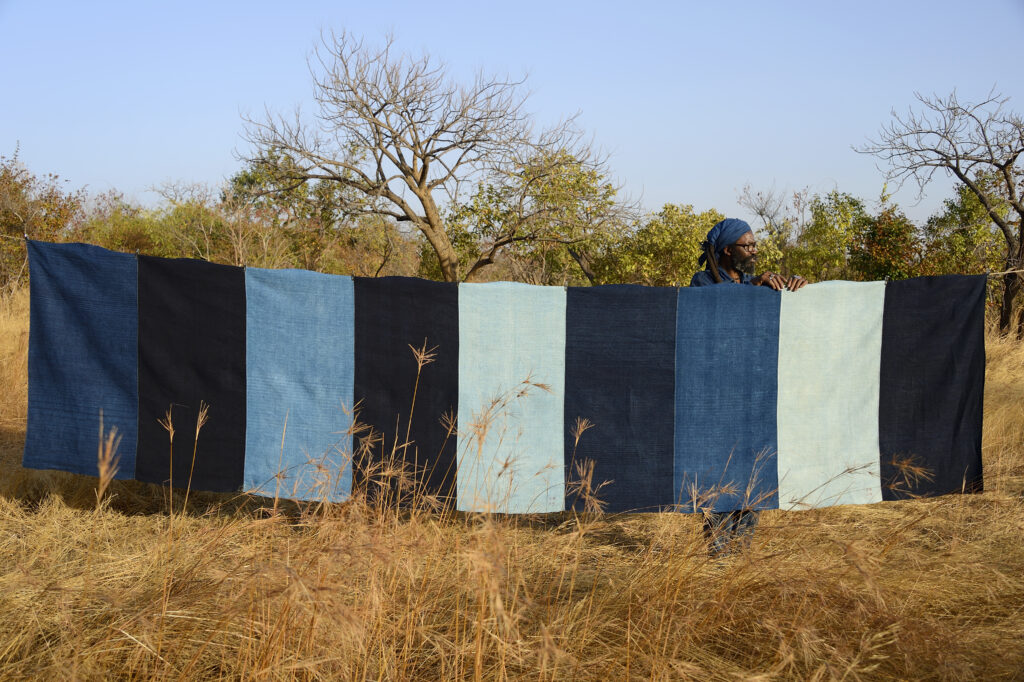
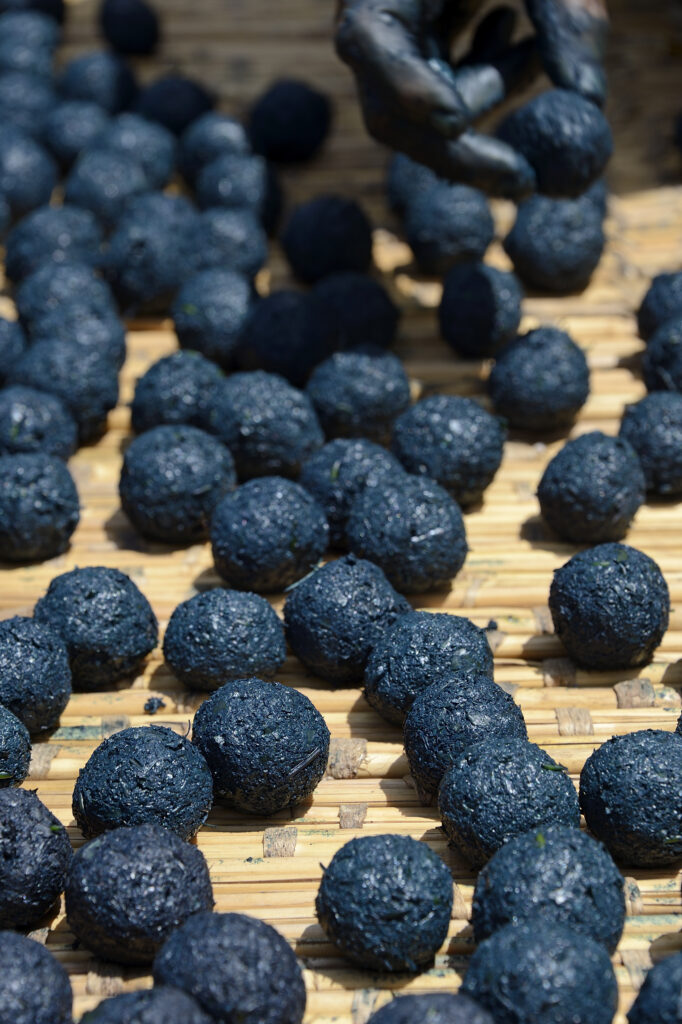
It is a work which involves all of my senses as well as all of my spirit, and it is a work which has built my life and my spiritual beliefs.
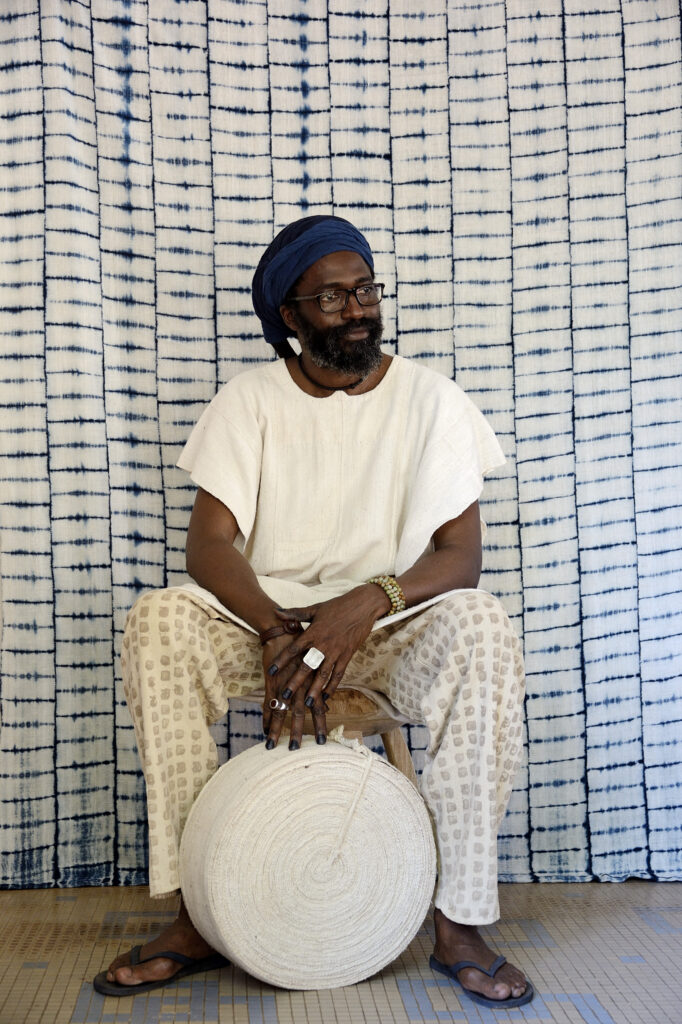
The way history speaks of Eliza Pinkney offers a clear example. Pinkney was the daughter of a colonial landowner whose family controlled many enslaved African people. In history she is recorded as the person who – almost single handedly – initiated the cultivation of indigo for dye in North America. But Pinkney was 17 when she began this work. She would have known less than nothing about the growing and processing of indigo. Her father knew nothing either. It was the people her father had enslaved who knew the real work. It was they who built the beginnings of indigo trade in North America. But while Eliza Pinkney’s name is well-known, I have not come across a reference to the name of a single one of the people who did the real labor and possessed the real knowledge. Even if their names are recorded somewhere, it would not be the names they were given at birth, because everything they were born with had already been stolen.
Indigo in Mali almost completely died out after Western colonisation. The French requisitioned and broke our economy and stole control of the cotton trade from our growers, spinners, and weavers, forcing them to produce white, long-staple cotton and leaving our many species of coloured cottons to disappear. Our complex indigo-dyeing techniques were discarded and broken, too. They could not be easily reproduced, scaled-up, transported – they could not be exploited. And as the hand-spinners and weavers of our sacred cottons disappeared; our indigo dyers themselves passed into memory. By the time I was born, the knowledge was already lost.
In over thirty years of searching, I have not ever met another indigo dyer in West Africa who does not use chemicals, who understands how to build and maintain a vat using only leaves. I had to turn to colonial accounts held in the Museum of Mankind (now the Quai Branly) to learn something that should have been my inheritance. It took me almost a decade of research, of travel throughout Mali, Guinea, Burkina Faso, Sénégal and Côte d’Ivoire, of collecting fragments and adding them to what I had learned in books, and then putting into practice what I had learned. I had so many vats fail and die, so many years of trying.
This may be a long way from the introduction of this piece, but for me, everything is a continuation. My ancestors, some of them, stayed in Africa. Some of them were stolen and taken elsewhere, but their souls remained African. Many of those taken would have been indigo dyers, and it is not unrelated that I could find no one to teach me my metier when I first began my journey into indigo. My ancestors led me to indigo because it was necessary for both of us to begin a healing – healing for myself and on behalf of my ancestors and my people. I cannot discuss my ideas of blue without discussing the history of the colour as it relates to my people, and without discussing our erasure from our own creations. For me, the blue of indigo is symbolic of many things, many deeply spiritual connections within my homeland. But it is also deeply symbolic of what colonialism has done to my region and my people, and to lands and societies elsewhere. I can talk about blue as a colour, as a shade, as an idea, as a spiritual practice. I cannot ever separate my work from my spirituality, and I equally cannot separate it from my political struggle for African liberation, which is ever-present in all my work. And when I am asked about my notions of the colour blue, as you can see, the answer is never simple.
Born in Mali and raised in France, Aboubakar Fofana is a multidisciplinary artist and designer whose working mediums include calligraphy, textiles and natural dyes. He is known for his work in reinvigorating and redefining West African indigo dyeing techniques, and much of his focus is devoted to the preservation and reinterpretation of traditional West African textile and natural dyeing techniques and materials.
To learn more about the work of Aboubakar Fofana visit aboubakarfofana.com / @aboubakarfofana
